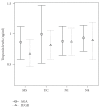Perinatal changes of cardiac troponin-I in normal and intrauterine growth-restricted pregnancies
- PMID: 17710247
- PMCID: PMC1939921
- DOI: 10.1155/2007/53921
Perinatal changes of cardiac troponin-I in normal and intrauterine growth-restricted pregnancies
Abstract
Intrauterine growth restriction (IUGR) implies fetal hypoxia, resulting in blood flow redistribution and sparing of vital organs (brain, heart). Serum cardiac Troponin-I (cTnI), a well-established marker of myocardial ischaemia, was measured in 40 mothers prior to delivery, the doubly clamped umbilical cords (representing fetal state), and their 20 IUGR and 20 appropriate-for-gestational-age (AGA) neonates on day 1 and 4 postpartum. At all time points, no differences in cTnI levels were observed between the AGA and IUGR groups. Strong positive correlations were documented between maternal and fetal/neonatal values (r > or = .498, P < or = .025 in all cases in the AGA and r > or = .615, P < or = .009 in all cases in the IUGR group). These results may indicate (a) normal heart function, due to heart sparing, in the IUGR group (b) potential crossing of the placental barrier by cTnI in both groups.
Figures


Similar articles
-
Serum fetuin-A/alpha2-HS-glycoprotein in human pregnancies with normal and restricted fetal growth.J Matern Fetal Neonatal Med. 2008 Nov;21(11):826-30. doi: 10.1080/14767050802326255. J Matern Fetal Neonatal Med. 2008. PMID: 19031279
-
Perinatal changes of circulating N-terminal pro B-type natriuretic peptide (NT-proBNP) in normal and intrauterine-growth-restricted pregnancies.Hypertens Pregnancy. 2007;26(4):463-71. doi: 10.1080/10641950701548414. Hypertens Pregnancy. 2007. PMID: 18066964
-
Circulating osteoprotegerin and sRANKL concentrations in the perinatal period at term. The impact of intrauterine growth restriction.Neonatology. 2009;96(2):132-6. doi: 10.1159/000211666. Epub 2009 Apr 8. Neonatology. 2009. PMID: 19365143
-
Intrauterine growth restriction, brain-sparing effect, and neurotrophins.Ann N Y Acad Sci. 2006 Dec;1092:293-6. doi: 10.1196/annals.1365.026. Ann N Y Acad Sci. 2006. PMID: 17308153 Review.
-
Review: Neuroinflammation in intrauterine growth restriction.Placenta. 2017 Jun;54:117-124. doi: 10.1016/j.placenta.2016.11.012. Epub 2016 Nov 25. Placenta. 2017. PMID: 27916232 Review.
Cited by
-
Cord blood ischemia-modified albumin levels in normal and intrauterine growth restricted pregnancies.Mediators Inflamm. 2008;2008:523081. doi: 10.1155/2008/523081. Mediators Inflamm. 2008. PMID: 18483569 Free PMC article.
-
Cardiac injury biomarkers in paediatric age: Are we there yet?Heart Fail Rev. 2016 Nov;21(6):771-781. doi: 10.1007/s10741-016-9567-2. Heart Fail Rev. 2016. PMID: 27255332 Review.
-
Intermediate Diastolic Velocity as a Parameter of Cardiac Dysfunction in Growth-Restricted Fetuses.Fetal Diagn Ther. 2016;39(1):28-39. doi: 10.1159/000431321. Epub 2015 Aug 12. Fetal Diagn Ther. 2016. PMID: 26279291 Free PMC article.
References
-
- Trevisanuto D, Picco G, Golin R, et al. Cardiac troponin I in asphyxiated neonates. Biology of the Neonate. 2006;89(3):190–193. - PubMed
-
- Gaze DC, Collinson PO. Interpretation of cardiac troponin measurements in neonates—the devil is in the details. Biology of the Neonate. 2006;89(3):194–196. - PubMed
-
- Hunkeler NM, Kullman J, Murphy AM. Troponin I isoform expression in human heart. Circulation Research. 1991;69(5):1409–1414. - PubMed
-
- Apple FS. Tissue specificity of cardiac troponin I, cardiac troponin T and creatine kinase-MB. Clinica Chimica Acta. 1999;284(2):151–159. - PubMed
MeSH terms
Substances
LinkOut - more resources
Full Text Sources
Research Materials
Miscellaneous

